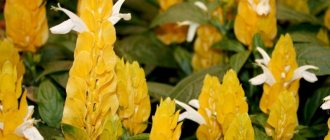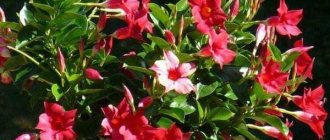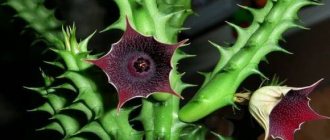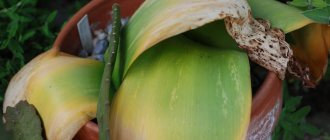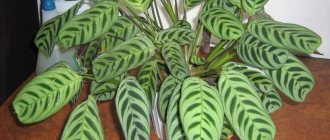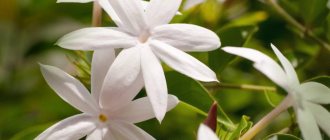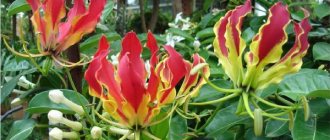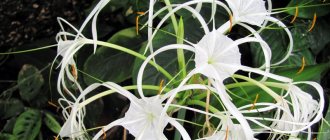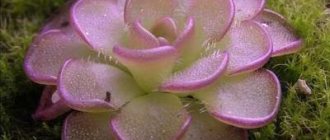Crossandra is an original plant with bright flowers, which Russian plant growers became acquainted with relatively recently. Crossandra is a tropical plant native to India. It is also common in East Asian countries, where its bright flowers used to decorate parks, gardens and temples. The flower belongs to the Acanthus species and has 50 varieties of shrubs.
This is a compact plant. Under natural conditions, the bushes reach one meter in height. In apartments it grows up to 60 cm, and low-growing varieties up to 35 cm.
As a houseplant, crossandra is quite demanding in terms of care.
Types of Crossandra
In the photo, the crossandra looks very impressive. This encourages professionals and amateur flower growers to purchase a flower to decorate their apartment, especially since the choice of varieties and colors is large.
Crossandra infundibuliformis
Crossandra funnel-shaped is a genus of bushes popular among gardeners. It is also called Crossandra undulate. This variety has glossy, dark green leaves and orange blossoms. The bush grows slowly, but grows large. It begins to bloom in the first year.
One of the famous varieties of this species is Crossandra Fortuna. Its representatives have a long flowering period. Yellow inflorescences up to 15 cm long.
Crossandra pungens
This variety is distinguished by dark leaves with white veins. Their size ranges from 2.5 to 12 cm. The flowers are small and yellow.
Crossandra Nile or nilotica (Crossandra nilotica)
Nilotica is also called Crossandra red. It has dark, leathery, dense leaves and pink or salmon-colored inflorescences.
Crossandra guineensis
This variety is easy to distinguish by a number of characteristics:
- the trunk is covered with short down;
- The upper side of the leaf is green, and the bottom has red veins.
- narrow inflorescences in the form of spikelets.
- flowers are white or pale purple.
Crossandra tropic and other yellow and pink varieties
One of the variants of the funnel-shaped crossandra. Dark, green leaves with pointed, wavy edges. The length of the inflorescence reaches 10 cm.
Crossandra red
Refers to low-growing varieties. The main distinguishing feature is the red-orange inflorescences, reaching 15 cm.
Blue Crossandra
It is also called “Blue Ice” for the amazing color of the petals. The leaves are dark, leathery, shiny.
Crossandra variegata
It differs from other representatives in the color of the leaves, which have multiple white spots. Plants of this variety are very demanding on lighting.
Ecbolium green
Lovers of exotic flowers are told about its rare variety “Green Ice”. However, professionals say that in this case we are talking about the Ekbolium plant. Like Crossandra, it belongs to the Acanthus family.
This is the reason for their external similarity and confusion in terminology. This flower attracts lovers with the rare color of its inflorescences - turquoise or sea green.
Crossandra Fortuna and other popular home varieties
It is possible to grow crossandra at home, but following all the rules of care. There are more than 50 plant species in nature. The most common variety in home keeping is funnel-shaped.
- Funnel-shaped (wavy-leaved, orange). It appeared in European greenhouses back in the 19th century. At home, the bush grows up to 50 cm in height. The diameter of the flowers is 2–3 cm. The corolla is bright orange.
Based on the funnel-shaped crossandra, other domestic hybrids were bred.
- Hybrid Fortuna . This favorite of flower growers appeared not so long ago. Salmon-orange flowers, a strong root system, resistance to temperature changes (tolerates drops of up to 10 °C), and a longer life span are the distinctive features of the variety.
- Prickly . A plant with bright yellow flowers and decorative variegated leaves with silver veins.
- Nile (red) . Red or pink flowers are collected in short inflorescences.
- Guinean . Quite rarely cultivated at home. Compact plant (up to 20 cm in height) with short-petioled leaves. Spike-shaped inflorescences consist of pale lilac or white flowers.
Photo gallery: types of crossandra
Fortuna is a long-liver among crossanders
Nile crossandra is also called red
Funnel-shaped crossandra is the most common variety for home cultivation.
Prickly crossandra has yellow flowers
Sometimes there is also a plant with blue flowers, erroneously called crossandra blue (turquoise) . Although this flower looks similar to its relatives from the Acanthaceae family, it actually belongs to the genus Ecbolium (unlike Crossandra, Ecbolium has 1-2 flowers in an inflorescence).
Ecbolium, unlike crossandra, has only 1–2 flowers in an inflorescence
Video: Meet Crossandra
Rules of care
In order for the plant to please the owner with beautiful leaves and lush flowering, two basic requirements must be met:
- maintain the proper degree of soil and air moisture;
- provide sufficient lighting levels.
Despite the apparent simplicity of the requirements, maintaining a balance of these factors in an apartment can be difficult.
Watering
Since crossandra is a tropical plant, it requires high air humidity and timely watering of the soil. The earthen clod must not be allowed to dry out. It is better to take soft water at room temperature for irrigation.
Illumination
Crossandra is photophilous, but it is better to place it out of direct sunlight. The decorative properties of the bush, including the length of flowering, depend on the length of daylight hours. In winter, when daylight hours are short, the flower must be illuminated with a phytolamp in the morning and evening.
When exposed to direct sun for a long time, as well as a prolonged lack of light, the leaves of the flower begin to fall off and it stops blooming.
Important! Crossandra does not tolerate drafts, so you need to choose a location for the flower where it will be located away from the windows, but will be sufficiently illuminated.
Temperature and humidity
Due to its origin, the flower is demanding on humidity conditions and ambient temperature. The flower loves warmth, but does not tolerate heat well. The optimal temperature for it in winter is -16-18 ºC, and in summer not lower than 20 ºC.
The bush must be sprayed regularly. At the same time, make sure that water does not get on the buds (otherwise the petals will fall off). To maintain the microclimate, you can use a humidifier or place the pot in a pan of water.
Important! The bottom of the pot should not touch the water, otherwise the plant will be in danger of overflowing. Expanded clay can be used as a stand under the bottom.
Soil and fertilizing
Loose, nutritious, slightly acidic soil is suitable for crossandra. A simple solution for a gardener would be to purchase ready-made soil in a store. Azalea substrate is suitable for growing this flower.
If the housewife does not trust the finished products, then she can mix the soil herself. This will require the ratio of the following components:
- Turf soil - 1/4 part;
- Sand - 1/4;
- Deciduous soil - 1/2.
Important! To prevent the water from stagnating in the pot, it is necessary to create a good drainage layer. Its thickness is 5 cm.
The plant needs regular feeding. In winter, you need to apply fertilizer once a month, and in spring and summer - once every 2 weeks. A complex fertilizer for flowering plants is suitable for these purposes.
Transplantation and crown formation
Young bushes are replanted annually. The optimal time for this is February - March. Mature plants need to be replanted once every two or three years. Transfers easily.
To form a beautiful lush bush, crossandra requires pruning. Heavy pruning is carried out during the dormant period (approximately in March), to approximately ½ the length of the branch. Young shoots are pinched as they grow, approximately 1/3 of their length.
Thanks to this, side shoots begin to actively develop in the bush.
On a note! Cut branches are suitable for rooting in water and soil.
How to care for heat-loving crossandra at home
Being an unpretentious plant, crossandra reacts sharply to lack of care and care. For successful cultivation, the plant needs to create comfortable conditions, which include:
- Good lighting.
- Room temperature.
- Proper watering.
- Wet air.
- Regular feeding.
- Timely transplantation.
The indoor herbaceous plant crossandra loves well-lit places. Best location: bright to semi-shaded. The plant does not tolerate direct sunlight, so windows oriented to the west and east are the best choice. If you place the flower on a south window, then you need to take care of protection from the bright sun. In the shade, crossander will develop poorly and may stop flowering.
Take a look at the photo of what an indoor crossander flower looks like in the interior of an apartment if you follow simple rules for caring for it:
It is important to note that the bush must be periodically turned with different sides towards the light so that it is not one-sided.
The plant loves warmth all year round, so it is important to maintain the appropriate temperature regime. The optimal temperature in summer is +22…+24 °C, in winter – not lower than +18 °C. In the warm season, the home heat-loving crossandra flower can be placed outdoors, in the garden or on the balcony, finding a place protected from drafts and rain. Sudden changes in temperature can adversely affect the plant, and it will most likely shed its leaves.
When growing flowering crossandra at home and caring for it, watering and spraying are important components of its successful development and growth. To choose the optimal tactics for watering a plant, you need to take into account the natural conditions of its growth.
The growing season pauses with the end of the rainy season and the beginning of the dry season. Therefore, watering: during the period of growth and flowering - abundant, 3-4 times a week, from October to February - limited. It is important to feel the difference between slightly moistened soil and damp soil.
You need to water with soft water at room temperature. The use of rainwater to water the flower is encouraged, and it is better to leave tap water for 24 hours to reduce the chlorine content in it.
Immediately after watering, it is imperative to drain the liquid from the pan so that the bottom of the flowerpot is not in water. If you ignore this recommendation, there is a risk of getting rotten roots and losing the plant.
When caring for a crossandra flower, it is important to provide the necessary air humidity at home. It should be high - up to 60%. A household humidifier or simple techniques will help maintain humidity levels at this level. For example, a pot with a plant is placed on a tray filled with wet expanded clay.
In addition, you can spray the soil and leaves more often, trying not to wet the flowers! The leaves respond very well to spraying, they straighten out, and the plant literally comes to life. But funnel-shaped flowers can rot from moisture.
If in winter the plant is placed near a heating radiator, then you can periodically spread wet towels on the radiator so that the air is not too dry. There is another simple trick - it is better to grow a tropical beauty in a ceramic flowerpot, since moisture does not evaporate from it as quickly as from a plastic one.
Replanting after purchase
After acquisition, the plant is quarantined. At this time, they allow him to get used to the new conditions and monitor his health, making sure that there are no diseases or pests. After 2 weeks, the newcomer is transplanted from the transport container into a permanent pot. It should be 4-7 cm larger than the transport one and have a good drainage layer.
Bloom
Crossandra blooms with spikelets of bright flowers. The most common color is orange.
Depending on the variety, they can be orange, yellow, pink, blue and green. With sufficient care, crossandra blooms from spring to autumn. Flowering is also possible in winter, but this greatly depletes the plant. Therefore, in winter the flower should be dormant.
It is recommended to remove bloomed buds in a timely manner. To do this, the flower stem above the top pair of leaves is cut. Thanks to this operation, new buds will appear on the bush.
Brief description of the plant
Crossandra belongs to the Acanthus family. These are herbaceous perennial plants and shrubs with bright inflorescences in shades of red, yellow and orange. They prefer warm tropical climates. The crossandra flower at home grows up to 50 cm, in nature it reaches a meter in height.
The plant attracts not only with its magnificent flowering, but also with beautiful foliage. The ellipsoid dark green leaves have a glossy surface and a rounded tip. The leaf length is about nine centimeters. The shoots are dark green or brownish-violet in color and have a branched structure. Spectacular inflorescences, collected in a spikelet, consist of four sides and reach 15 centimeters in height. The inflorescence will unravel gradually, from the bottom of the ear to the top.
It is generally accepted that the first plant was brought to Europe along with tea in the first half of the 19th century from the island of Ceylon. Its name is formed from two Greek words krossos and andr. Which means “fringe” and “male” in translation. The crossandra flower is widespread in India, the island of Madagascar, Arabia and Africa. In nature, more than fifty plant varieties bloom all year round. In home floriculture, it is customary to grow only a few species: the most popular are Crossandra funnel-shaped and its hybrid. Crossandra guinea, nilotica, and crossandra prickly are found a little less frequently.
Possible problems in growing
Improper care or inappropriate conditions for keeping crossandra lead to a number of problems.
- Falling leaves . This problem is caused by: low air temperature, drafts, excess direct sunlight and insufficient watering.
- Blackening of leaf tips. This is a fairly common problem that occurs due to low air humidity. For the same reason, the leaves of the flower curl.
- Loss of decorative properties . Occurs as a consequence of soil depletion and lack of microelements. A sign of this problem is the light color of the inflorescences and the pale green color of the leaves of the crossandra.
- Sparse flowering or lack of flowers . The reason is insufficient lighting. The number of buds also decreases as the plant ages (after 4 years). Affects the number of buds and the quality of flower pruning. If pruning is too strong, few buds with buds are formed.
- Damage by diseases and pests. Crossandra is susceptible to mold development, as well as damage from insects (aphids, spider mites). When mold appears, the flower is treated with a fungicide, and against insects with insecticidal preparations.
Pests and diseases
Diseases and their treatment
Because crossandra loves moist soil and air, it is often affected by leaf mold. If you find spots of fluffy gray mold on the leaves, immediately cut out all the affected areas, including healthy tissue, treat the plant with a fungicide solution, adjust the air humidity in the room and balance the watering.
All other painful conditions of crossandra arise from improper care. For example:
- Pachistachis at home: care and types
- From insufficient or infrequent watering, the leaves of the plant begin to wither and then fall off.
- Crossander also loses leaves due to sudden temperature changes.
- Poor flowering is sometimes explained not only by aging or improper pruning of the crossandra, but also by insufficient lighting.
- If you created conditions close to natural for the plant and provided it with nutrition and moisture, then the crossandra should not have any health problems.
In the photo: Growing crossandra in an apartment
Pests and their control
In a room with a low level of air humidity, the crossandra can be attacked by spider mites - tiny pests that are dangerous primarily because they are difficult to detect. By the time you notice that a thin web has appeared on the plant, the pests will probably already have time to multiply.
If there are a small number of mites, simply wash the plant in the shower with cold water, but if several generations of pests have appeared, then you cannot do without treating the crossandra with acaricides.
Buy Actellik, Aktaru, Akarin or Fitoverm at the garden pavilion and treat the flower leaf by leaf with a solution of one of the listed drugs.
Reproduction
You can propagate a flower in two ways:
- By cuttings. This is a simple method that gives good rooting results. Cuttings 10-15 cm long should be sprinkled with a growth stimulator. Then plant it in a container with soil made from a mixture of turf, sand and peat. All components must be mixed in equal parts. The shoots take root well in the light, at a temperature of 20-22º C for one month. If necessary, the container can be covered with a bag. After two months, the young plants are planted in separate pots. In order for the bushes to grow lush, 2-3 shoots are planted in a pot.
- Propagation by seeds is quite a troublesome task. First, the seeds must be soaked for 3-6 hours. Sow them in the ground and cover with a bag. Seed germination occurs within two to three weeks. This requires high humidity and an air temperature of about 24º C. After a month, the grown seedlings are transplanted into separate pots.
Watch the video for details:
How does the crossandra flower reproduce?
There are two popular ways to propagate a plant: using cuttings and using seeds. Let's take a closer look at each.
Propagation by cuttings
When a plant is pruned, each healthy cutting that is formed can be used for rooting. The length of the cutting can be from 8 to 10 centimeters.
— Rooting method 1
First you need to remove the leaves and treat the cuttings with Kornevin (or Epin, or Zircon), which promotes growth and root formation. Then plant at an angle in specially prepared soil (moist sand and peat) and cover with polyethylene.
Create a temperature regime within 25 degrees in good lighting (this could be, for example, a windowsill with a radiator or a greenhouse). The root system will appear in about 20 days. During these three weeks, the soil should be moistened and the greenhouse should be regularly ventilated.
When the cuttings take root and 2-3 leaves appear on each, it is worth replanting. You will need potting containers with a diameter of 90 mm in which nutritious soil is placed. 3 seedlings are transplanted into each pot. Don't forget to pinch the plant to make it fuller.
— Rooting method 2
The main assistant here is a glass of water. In order not to provoke rotting of the cuttings, add activated carbon to the water (1 tablet per glass of water). A little Kornevin is also added here in order to stimulate the formation of the root system. There is no need to change the contents of the glass, just add water little by little. Roots can be seen after 20-30 days. As soon as they grow to 10 mm, transplant the cuttings into pots for better adaptation to the soil.
— Rooting method 3
A popular method of rooting cuttings is using peat tablets. First, the tablets are moistened with water, then each tablet is squeezed out and a small indentation is made.
The cuttings are first treated in a means that stimulates root formation (for example, in Kornevin) and stuck into the middle of the tablets. Each tablet with a stalk is placed in a transparent glass and covered with the same glasses. This design is secured with tape and left in a warm place and in good light for a month. During this period, the root system will appear. Further actions are the same as in rooting method 1.
Propagation using seeds
There is no guarantee that seeds collected at home will produce a beautiful plant. This opinion is associated with the hybrid form of the indoor plant. Store-bought seeds are also not a very stable option, since everything depends on the manufacturer and the quality of his products.
Nevertheless, for gardeners, it is most preferable to propagate crossandra from collected seeds of a domestic plant. There is a chance that he will grow up more beautiful and healthy than his parent.
First, make a warm solution (25°C) with a growth stimulator (Zircon, for example, is suitable), where we place our seeds to soak for a couple of hours. It should be noted that only store-bought crossandra seeds are soaked, since homemade ones germinate safely on their own.
Next, prepare the soil mixture, which includes:
- peat;
- sand;
- coconut fiber and sphagnum moss.
This mixture has excellent air permeability and moisture permeability, which is very valuable when planting seeds and has a good effect on germination.
Sowing is done 5 mm deep into the soil, cover the planting with polyethylene and place it in a warm, bright place. They can withstand temperatures of 20-22 degrees with humidity over 70 percent. After a couple of weeks, the seeds will begin to germinate. Planting care consists of ventilating the greenhouse and moistening the soil with a spray bottle, if necessary.
Higher temperatures (about 30) have a positive effect on seed germination.
After about 30 days, the sprouts are transplanted into 6-centimeter potted containers. Later, in the summer, the plants are replanted again (transshipment), but into larger pots (10 cm in diameter). Then don’t forget about pinching the tops.
